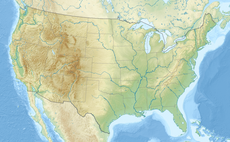geo.wikisort.org - Mountains
Mitten Rock is a 6,557-foot (1,999 meter) elevation summit located on Navajo Nation land in San Juan County of northwest New Mexico, United States.[3] Mitten Rock is set in the northeastern part of the Navajo Volcanic Field, a volcanic field that includes intrusions and flows of minette and other unusual igneous rocks which formed around 30 million years ago during the Oligocene.[4] Mitten Rock is one of the major diatremes of the Four Corners area, and with significant relief as it rises 900 feet (275 meters) above the high-desert plain.[5] It is situated about 8.5 miles (13.7 km) southwest of Shiprock, the most famous of these diatremes. Mitten Rock has also been known as "Little Ship Rock."[3] This landmark is called Tséłkǫ, meaning "Rock Is Fire" in the Navajo language.[6] This geographical feature's descriptive name was applied by the US Army in 1892, and was officially adopted in 1915 by the U.S. Board on Geographic Names.[3] Precipitation runoff from this feature drains into Little Shiprock Wash, which is part of the San Juan River drainage basin. According to the Köppen climate classification system, Mitten Rock is located in a semi-arid climate zone with cold winters and hot summers.[7]
| Mitten Rock | |
|---|---|
 Northeast aspect | |
| Highest point | |
| Elevation | 6,557 ft (1,999 m)[1] |
| Prominence | 807 ft (246 m)[1] |
| Parent peak | White Rock (6,634 ft)[2] |
| Isolation | 5.37 mi (8.64 km)[1] |
| Coordinates | 36°36′33″N 108°56′40″W[3] |
| Geography | |
 Mitten Rock Location in New Mexico  Mitten Rock Mitten Rock (the United States) | |
| Location | San Juan County, New Mexico, US |
| Parent range | Chuska Mountains[2] Colorado Plateau |
| Topo map | USGS Mitten Rock |
| Geology | |
| Age of rock | Oligocene |
| Mountain type | Volcanic plug |
| Type of rock | Volcanic breccia |
Geology
Mitten Rock is composed of felsic minette, unusual even for the Navajo volcanic field. Felsic minette has a silica content of up to 60%, versus the more typical 48% to 52% silica content of the more typical mafic minettes of most vents in the volcanic field. This magma was likely formed by crystal fractionation of more typical mafic minette magma.[8]
See also
- Rock formations in the United States
- Volcanic plug
References
- "Mitten Rock - 6,557' NM". listsofjohn.com. Retrieved 2020-12-02.
- Mitten Rock, Peakvisor.com, retrieved December 2, 2020
- "Mitten Rock". Geographic Names Information System. United States Geological Survey. Retrieved 2020-12-02.
- Steven C. Semken, The Navajo Volcanic Field, in Volcanology in New Mexico, New Mexico Museum of Natural History and Science Bulletin 18, p. 79, 2001. ISSN 1524-4156
- Robert Julyan, The Mountains of New Mexico, 2006, University of New Mexico Press, page 109.
- Stephen C. Jett and Editha L. Watson, Sacred Places of the Navajo, 1993.
- Peel, M. C.; Finlayson, B. L.; McMahon, T. A. (2007). "Updated world map of the Köppen−Geiger climate classification". Hydrol. Earth Syst. Sci. 11 (5): 1633. Bibcode:2007HESS...11.1633P. doi:10.5194/hess-11-1633-2007. ISSN 1027-5606.
- Roden, M.F. (1981). "Origin of coexisting minette and ultramafic breccia, Navajo volcanic field" (PDF). Contributions to Mineralogy and Petrology. 77 (2): 195–206. Bibcode:1981CoMP...77..195R. doi:10.1007/BF00636523. S2CID 129590194. Retrieved 27 July 2021.
External links
- Weather forecast: National Weather Service
- Mitten Rock rock climbing: Mountainproject.com
Другой контент может иметь иную лицензию. Перед использованием материалов сайта WikiSort.org внимательно изучите правила лицензирования конкретных элементов наполнения сайта.
WikiSort.org - проект по пересортировке и дополнению контента Википедии